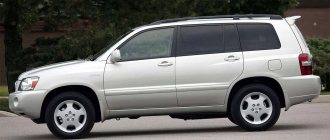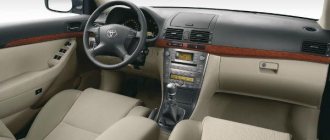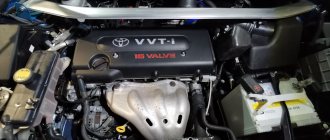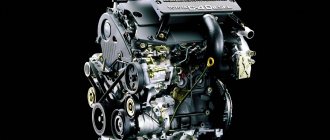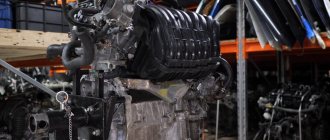All owner reviews about Toyota Avensis III
The car was bought in May 2005 for my wife. My love set a condition - only automatic transmission. After training trips with an instructor in a VAZ 2110, she developed a persistent phobia of manual transmissions. Before getting to the auto center, we managed to visit dealers of Skoda, Peugeot and Opel. At the beginning, I really liked the New Octavia with a 2-liter diesel engine and DSG preselective mechanics. However, the prospect of waiting for her for 4-5 months dampened our enthusiasm. The new Opel Astra disappointed with its sluggish dynamics and noisy engine (by the way, the interior in the “quadraktish, praktish, gut” style also made a depressing impression). We tuned in to a fully equipped Peugeot 307, the next day I had to go pay, but... Returning home from work, I heard on the radio about a Toyota advertising campaign - “new Avensis, automatic transmission as a gift.” And I think: let me stop by, at least I’ll take a look, I’m going past Balaklavka anyway. And I stopped by. I’ll say right away that after I sat in the Avensis salon, I realized that neither Peugeot nor Opel were comparable in quality of finish (except for the fabric on the seats). The decision to purchase was made within 2 minutes. 2 liters, automatic transmission and a bunch of fixed options for which the “Germans” would rip me off like crazy. And here for everything 27900 US dollars. rubles 4 days of waiting and forward. The first impression is that the engine is very quiet (I drove a 2000 MB E430 at the time), but after 3 thousand revolutions a low-frequency hum begins (apparently this is the design of the exhaust tract), there is no point in turning it above 3 thousand. The suspension is very soft and at the same time dense, no knocks or rattles. The music is so-so (after the Mercedes Bose), but it’s enough for my daughter to listen to the radio and CDs with children’s songs from cartoons. The 4-speed automatic knows its stuff well, but nothing more. The brakes are excellent (believe me, there is something to compare with). And the turning circle is like a trolleybus. In short, a quiet family car. Quiet, comfortable, and most importantly terribly safe - after all, 9 pillows and the blaring buzzer of unfastened seat belts will keep my loved ones out of trouble. The trunk is roomy, the interior is spacious. What else do you need? Racing is not for this car; its element is smooth movement in the space of a metropolis and leisurely (120-150 km/h) trips to the country.
Today the mileage is 17 thousand km. At the first maintenance, the oil and filter were changed (for $120 in total), and the burnt-out lampshade in the trunk was replaced under warranty. There haven't been any more problems so far. Instead of the standard halogen lights, I installed xenon - $400 (looks great), an alarm system, locks on the hood and gearbox (another $1100). Plus insurance ($2300). Average fuel consumption in the city is 9.5 liters, on the highway - 7.5-8 liters.
Yesterday (October 25, 2005) we switched to Gislaved Nort Frost 3 winter tires. And today it snowed, guess what.
Toyota Avensis 2010
Good day everyone, I decided to write my review of the 2010 Toyota Avensis. I just want to tell you about my car, and even the owner of the site promises some money for the review, which is a small thing, but it’s nice. This is my first time writing a review, so please be understanding. Our car was purchased in the summer of 2010. The car was bought for a family, therefore, the wife also drives, so a car with an automatic transmission or an equivalent was considered. Avensis has a CVT, which was also suitable. Before Avensis, there were mostly right-hand drive cars, and also Toyotas. The first Toyota Corolla 4 wd 2004 and the second Toyota Camry 2003. I like Toyotas, so I also decided to take a new car from this family. At first I wanted to take a Camry, but I couldn’t afford the money, taking into account that I took out a loan. Now to the point: 1.8 liter engine (147 hp), CVT gearbox, leather interior, alloy wheels, silver color. Prestige Plus package. There is no point in describing everything according to the model’s configuration, go to the website and read it. It was my first time buying a new car, so I was a little worried. After ordering the car we had to wait a bit. Although the OD said that the car would arrive only in a couple of months, the car arrived in three weeks. When the salon manager called, I thought my heart would jump out, I just didn’t know what or how to do, it was the first time it was a new car. But everyone arrived, processed it, and took it away. Immediately to the gas station, because the light was on. In the cabin, the OD was additionally equipped with engine crankcase protection, mud flaps without them you will not pass the maintenance, and for some promotion they sold floor mats and a carpet in the trunk (supposedly with a 50% discount). From that moment on, the operation of my Toyota began. Now the pros and cons: PROS: 1) Beautiful appearance, I would say best in class. Personally, that’s why I bought it, because I liked the car’s appearance. 2) The Avensis's interior is large and spacious, one complaint is the space for the feet of the rear passengers who sit behind the driver's seat. I also like the trunk, it is very practical and convenient. 3) Comfortable steering wheel, I personally like it 4) Good finishing of the instrument panel, soft-touch plastic, good ergonomics, a lot of buttons, sockets, everything is clear and works correctly. 5) My Avensis is equipped with a start button and starts without a key. It’s very convenient to throw the keychain into your bag and forget about it. I was also pleased with the handbrake, also via a button. 6) The engine is quite enough, but for the wife it’s too much for the eyes, she can speak more softly! Women are afraid of driving fast. 7) The operation of the variator is normal, although it definitely takes some getting used to. The first two right-hand drive Toyotas worked much more clearly, but they had an ordinary automatic transmission. Now I’m used to it and I try to do on the automatic what I do on the variator, in general, it’s a matter of habit. Now the disadvantages, they also exist: 1) When starting, for about a minute, until the engine warms up, a strange sound is heard, as if something was rattling. I come to the OD and say, so and so, they show me, I specifically left the car near the salon for it to cool down. I start it, there is no sound, but no, no, the receptionist shrugs his shoulders, I just can’t figure out this sound. 2) The driver's seat is not very comfortable, despite the fact that there are a lot of different adjustments, it is still uncomfortable if you have been driving for a long time and you have to stop after a couple of hours to arch your back. As long as I don't change the settings, there's no point. 3) The leather in the cabin, on the one hand, is not difficult to like and care for. However, in winter it’s not so comfortable; it feels like you’re sitting on ice. The heated seats work somewhat slowly; it’s better not to get into the cabin before 10 minutes. This was not the case on right-handed Toyotas; everything warmed up in an instant, although the interior was made of fabric. Maybe this is the problem, maybe it’s specially set up to damage the skin. I bought a sheepskin cape for the winter, and it’s the only way I can save myself. 4) It is written that the Toyota Avensis is adapted for winter conditions, for Russian roads, and the bumper is high, but it seems to me that the height is not enough, considering how our roads are cleaned, if you can still somehow move around the city until just outside the city (trips to your mother-in-law to the village) in winter turn into a very difficult challenge. 5) Especially in my review of the Toyota Avensis, I would like to mention the paintwork of the car. This is actually a song, and a sad one at that. After the winter, strange circular marks appeared, I went to the OD, they said that many cars have this, supposedly poor quality paintwork. At a third-party station they said that it needs to be polished, maybe it will help! It's a Toyota! Right-hand drive cars had paintwork as good as new after so many years. There is a specific disadvantage here, the manufacturer should think about it! 6) There are also crickets in the interior, one lives in the front panel, I can’t figure it out, and in the back near the right side of the sofa, I also can’t defeat it, but I have a suspicion where it is based. 7) Sound insulation at a budget level. No, of course, it’s better than, say, people’s cars. However, it falls short of its class. The noise is especially bad on the wheel arches of the car. Another minus of the variator, as I wrote above, took a long time to get used to. Either the engine spins up to 3 thousand at a speed of 100 km/h, then 3 thousand at 140 km/h. It’s not clear somehow. However, I like the sport mode, you press it and after three seconds the car becomes like a rocket, especially when overtaking you need more cargo. By the way, there is a 350 thousand kilometer guarantee on the CVT. Well, that’s probably all, I’ll rate the car 8 out of 10, right-hand drive Toyotas were much better quality, now the manufacturer is saving a little.
I just want to tell you about my car, and even the owner of the site promises some money for the review, which is a small thing, but it’s nice. This is my first time writing a review, so please be understanding. Our car was purchased in the summer of 2010. The car was bought for a family, therefore, the wife also drives, so a car with an automatic transmission or an equivalent was considered. Avensis has a CVT, which was also suitable. Before Avensis, there were mostly right-hand drive cars, and also Toyotas. The first Toyota Corolla 4 wd 2004 and the second Toyota Camry 2003. I like Toyotas, so I also decided to take a new car from this family. At first I wanted to take a Camry, but I couldn’t afford the money, taking into account that I took out a loan. Now to the point: 1.8 liter engine (147 hp), CVT gearbox, leather interior, alloy wheels, silver color. Prestige Plus package. There is no point in describing everything according to the model’s configuration, go to the website and read it. It was my first time buying a new car, so I was a little worried. After ordering the car we had to wait a bit. Although the OD said that the car would arrive only in a couple of months, the car arrived in three weeks. When the salon manager called, I thought my heart would jump out, I just didn’t know what or how to do, it was the first time it was a new car. But everyone arrived, processed it, and took it away. Immediately to the gas station, because the light was on. In the cabin, the OD was additionally equipped with engine crankcase protection, mud flaps without them you will not pass the maintenance, and for some promotion they sold floor mats and a carpet in the trunk (supposedly with a 50% discount). From that moment on, the operation of my Toyota began. Now the pros and cons: PROS: 1) Beautiful appearance, I would say best in class. Personally, that’s why I bought it, because I liked the car’s appearance. 2) The Avensis's interior is large and spacious, one complaint is the space for the feet of the rear passengers who sit behind the driver's seat. I also like the trunk, it is very practical and convenient. 3) Comfortable steering wheel, I personally like it 4) Good finishing of the instrument panel, soft-touch plastic, good ergonomics, a lot of buttons, sockets, everything is clear and works correctly. 5) My Avensis is equipped with a start button and starts without a key. It’s very convenient to throw the keychain into your bag and forget about it. I was also pleased with the handbrake, also via a button. 6) The engine is quite enough, but for the wife it’s too much for the eyes, she can speak more softly! Women are afraid of driving fast. 7) The operation of the variator is normal, although it definitely takes some getting used to. The first two right-hand drive Toyotas worked much more clearly, but they had an ordinary automatic transmission. Now I’m used to it and I try to do on the automatic what I do on the variator, in general, it’s a matter of habit. Now the disadvantages, they also exist: 1) When starting, for about a minute, until the engine warms up, a strange sound is heard, as if something was rattling. I come to the OD and say, so and so, they show me, I specifically left the car near the salon for it to cool down. I start it, there is no sound, but no, no, the receptionist shrugs his shoulders, I just can’t figure out this sound. 2) The driver's seat is not very comfortable, despite the fact that there are a lot of different adjustments, it is still uncomfortable if you have been driving for a long time and you have to stop after a couple of hours to arch your back. As long as I don't change the settings, there's no point. 3) The leather in the cabin, on the one hand, is not difficult to like and care for. However, in winter it’s not so comfortable; it feels like you’re sitting on ice. The heated seats work somewhat slowly; it’s better not to get into the cabin before 10 minutes. This was not the case on right-handed Toyotas; everything warmed up in an instant, although the interior was made of fabric. Maybe this is the problem, maybe it’s specially set up to damage the skin. I bought a sheepskin cape for the winter, and it’s the only way I can save myself. 4) It is written that the Toyota Avensis is adapted for winter conditions, for Russian roads, and the bumper is high, but it seems to me that the height is not enough, considering how our roads are cleaned, if you can still somehow move around the city until just outside the city (trips to your mother-in-law to the village) in winter turn into a very difficult challenge. 5) Especially in my review of the Toyota Avensis, I would like to mention the paintwork of the car. This is actually a song, and a sad one at that. After the winter, strange circular marks appeared, I went to the OD, they said that many cars have this, supposedly poor quality paintwork. At a third-party station they said that it needs to be polished, maybe it will help! It's a Toyota! Right-hand drive cars had paintwork as good as new after so many years. There is a specific disadvantage here, the manufacturer should think about it! 6) There are also crickets in the interior, one lives in the front panel, I can’t figure it out, and in the back near the right side of the sofa, I also can’t defeat it, but I have a suspicion where it is based. 7) Sound insulation at a budget level. No, of course, it’s better than, say, people’s cars. However, it falls short of its class. The noise is especially bad on the wheel arches of the car. Another minus of the variator, as I wrote above, took a long time to get used to. Either the engine spins up to 3 thousand at a speed of 100 km/h, then 3 thousand at 140 km/h. It’s not clear somehow. However, I like the sport mode, you press it and after three seconds the car becomes like a rocket, especially when overtaking you need more cargo. By the way, there is a 350 thousand kilometer guarantee on the CVT. Well, that’s probably all, I’ll rate the car 8 out of 10, right-hand drive Toyotas were much better quality, now the manufacturer is saving a little.
Best auto reviews
Review of Toyota Avensis 1.8 VVT-i (2011)
Good day to all. I decided to share my impressions of the 2011 Avensis. Before this there was a Passat sedan B6 automatic transmission ComfortLine, German assembly. I've run almost 130,000 km in three years - it's time to change the horse. I will compare it with this car. I would like to note the fact that when we bought the Passat, the choice was also between Avensis (the previous one) and the Passat (already B6), and then the Passat won. But now... After rummaging around in the new car market, I found a large number of offers, but after getting to know these offers more closely... In short, I made a choice in favor of Avensis. Prestige+ equipment (sedan, 1.8, CVT, adaptive xenon, leather, 17 wheels, made in England). Mileage at the time of writing this review is 7,500 km.
I remember when I saw the “face” of the new Avensis back in 2009, I thought: “what a freak.” I looked at the back - “nice ass.” 2 years and many thousands of kilometers have passed. I rarely came across Avensis cars, but when I did, they caught my eye. I looked and thought, why do people buy these cars? The price tag is like the Camry, so it’s better to get “more car for the same money”? And, apparently, somewhere inside there was a worm. Gradually, monitoring the growing mileage of my own car, I began to define selection criteria for myself. For the future. I realized that I don’t want to go to “C” yet, “E” is a lot, since I mostly travel alone or with 1 passenger. Sometimes you need to take your family to the village and then pick it up from there. In general, it turned out that “D” was what we needed. The Passat was 100% satisfied in this regard. And I also don’t want the Russian assembly. And if now the “golfy” face, the “audible” price, the imposed turbo engines, the practically old interior and Russian hands had not come together at one point - who knows, maybe I would have become the owner of the B7. Got distracted. So, first impressions:
Body . Judging by the brochures and manuals, the dimensions of the Avensis are almost the same as those of the B6. However, visually the Avensis muzzle is less long (although the size from the front axle to the cut of the bumper is the same). In general, it seems to me that the Passat looked significantly larger. Avensis looks more compact. I have already noticed something positive: in rainy weather the rear view mirrors and side windows do not get dirty (B6 owners will understand me). External door handles are much less dirty.
Salon . It's comfortable for me to sit. Higher than in the Passat. Accordingly, it is easier to get out. I settled in right away (unlike the Passat, in which I was never able to find the optimal seating position, as I already wrote about). In general, the interior is normal, calm, not creaky. There are clues. I would like to raise the armrest higher, but this is impossible (I remember kindly B6). But the volume of the armrest box is much larger than it was in the Passat. I also want to put my left elbow on the driver’s door trim near the window, but I can’t do this - the trim is beveled (but it worked in the Passat). The interior rear-view mirror lowers itself on large potholes (well, I don’t even know what to compare this with - it was just a shock at first). The rear window buttons on the driver's door are placed in such a way that you either need to turn your hand out or use your little finger. There is less space behind the driver (me) in the Avensis than there was in the Passat. But all the same, the rear passengers are quite comfortable (this feeling is also complemented by the absence of a tunnel, the floor is flat). In principle, in the driver’s seat I feel quite comfortable and, one might say, cozy. The instruments are all readable and quite informative. At first I didn’t understand the logic of the fuel remaining readings. I surfed the forums and figured it out (it turns out that he considers the reserve of 150 km to be completely zero, i.e., simply put, the tank is 60 liters, but he estimates 48 of them, considering 12 as an absolute reserve). Noise insulation is no worse than in the Passat. But not better either. The glove box in the Avensis is huge, but there are stampings in the door pockets for small bottles. Therefore, you have to put 1.5 liters in the glove compartment, which significantly eats up its useful volume. Climate control does not cause any inconvenience, there are no complaints about it.
Hood and trunk . I will highlight it separately. In the Passat, the open hood was supported by a hydraulic stop; in the Avensis, you need to install a support. At first the hood dropped a couple of times. In Avensis, it’s nice to be able to check the windshield washer fluid level. Everything else is covered with plastic. A questionable decision, especially regarding the battery area (the plastic piston can “crunch” in our winters). The trunk in the Passat is larger, its ergonomics are better (I mean dedicated areas on the sides and a hook for bags). I fitted the Passat hook into the Avensis - now I enjoy the opportunity not to collect bags and packages throughout the luggage compartment. However, you need to understand that “smaller than in the Passat” does not mean small! The trunk is large. We took the bike to the village, removing only the front wheel and the bags. I had to fold out one part of the rear seat (the length of the bike did not fit). But in the Passat there was exactly the same picture. I was also struck by the trunk lid, slamming shut with such a sound as if it were a VAZ. The first time I even re-closed it - it didn’t help, of course.
Variable speed drive . No matter how hard I tried, I still couldn’t understand the logic of its operation. At the same speed, at the same riding pace, I can get both 2200 rpm and 2700 rpm. At first I tried to get into it, then I gave up. I liked the “sport” mode; I use it on the highway when overtaking. In terms of dynamics, it seems to me that Avensis is faster than the Passat that I had (2.0 FSI automatic transmission-6 Tiptronic). What was alarming was the heating of the variator in Moscow traffic jams - my right leg was noticeably warmer than it was in the Passat. I touched the box lock - it was hot. Not warm, but hot. I didn’t delve into how the variator cooling system works and whether it exists. Scored. As it is, so it is. It doesn’t jerk, it rides smoothly, which means everything is fine.
Engine . 147 l/s. Quiet (again, compared to FSI). You can't hear it in the cabin. Even when accelerating quickly, you can hear the whirring of the CVT rather than the sound of the engine. It’s too early to talk about fuel consumption, but it’s clearly higher than what’s written in the manual. Yes, and while there was a running-in mode, it didn’t make sense to particularly detect it.
Suspension and road behavior . The suspension behaves differently. It should also be noted that Avensis is equipped with the “ECO” package, and for this option the recommended tire pressure is 2.7 for the front and 2.5 for the rear. Despite this, I feel more comfortable driving in the Avensis both in the city and on the highway. It handles well on the road, corners at high speed worse than the Passat, and rolls more. It seemed to me that it is more demanding on the quality of the road surface (specifically in corners). But this is not critical - I’ll be more alive. The turning radius is significantly smaller than that of the Passat and is more convenient in the city.
I would like to draw your attention to the fact that I deliberately did not write about such things as adaptive xenon, rear view camera, etc., since the previous car did not have this, and this description will add inadequate delight. I wanted to compare the parameters that most Avensis and B6 Passats have and draw attention to the obvious pros or cons for me. Well, as for the “extras”, they are just “extras”, to improve our automobile life.
That's probably all. Now let’s look at maintenance and reliability, maybe by 50,000 km there will be more to write about. Good luck and patience to everyone on the roads.
